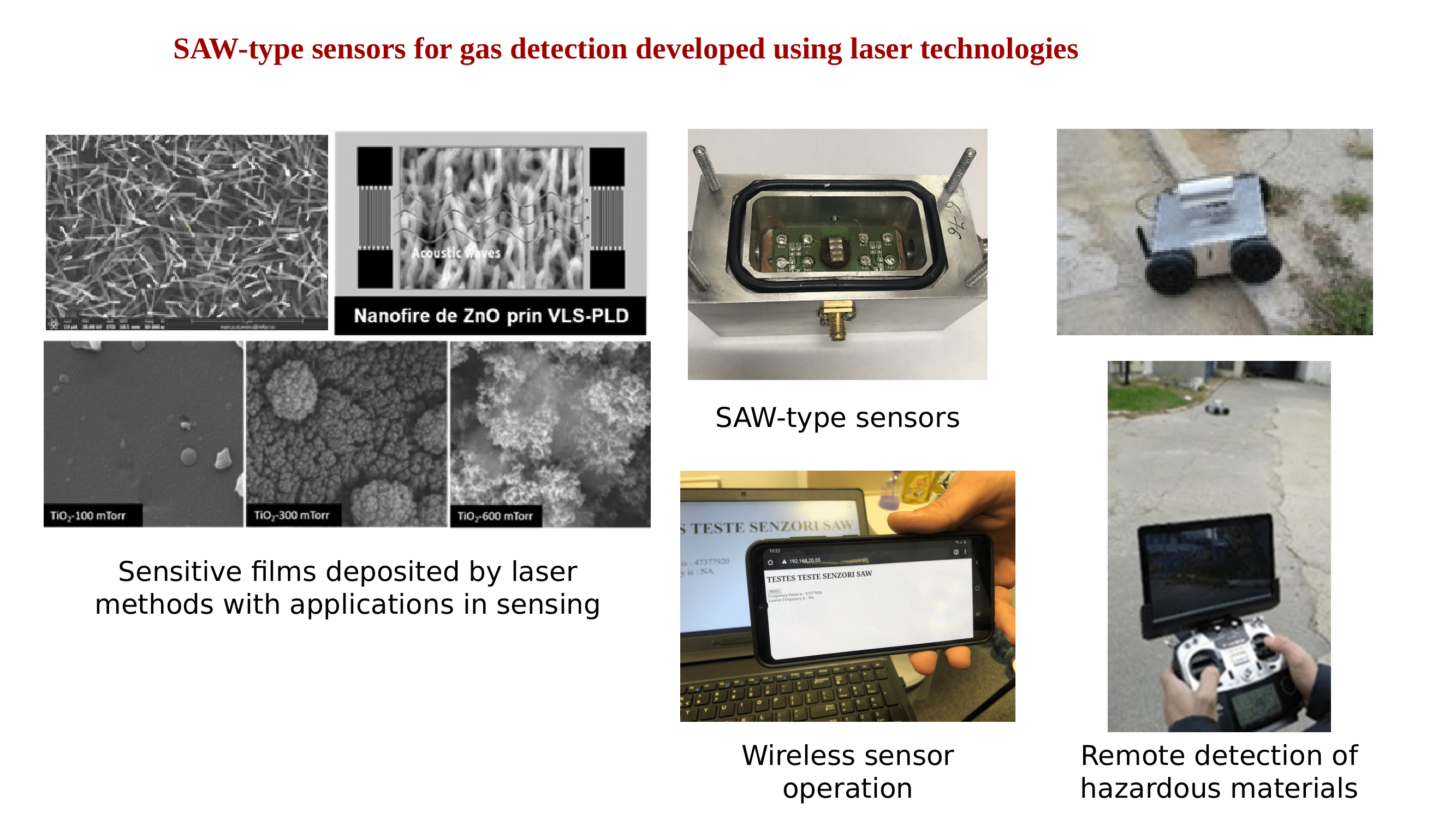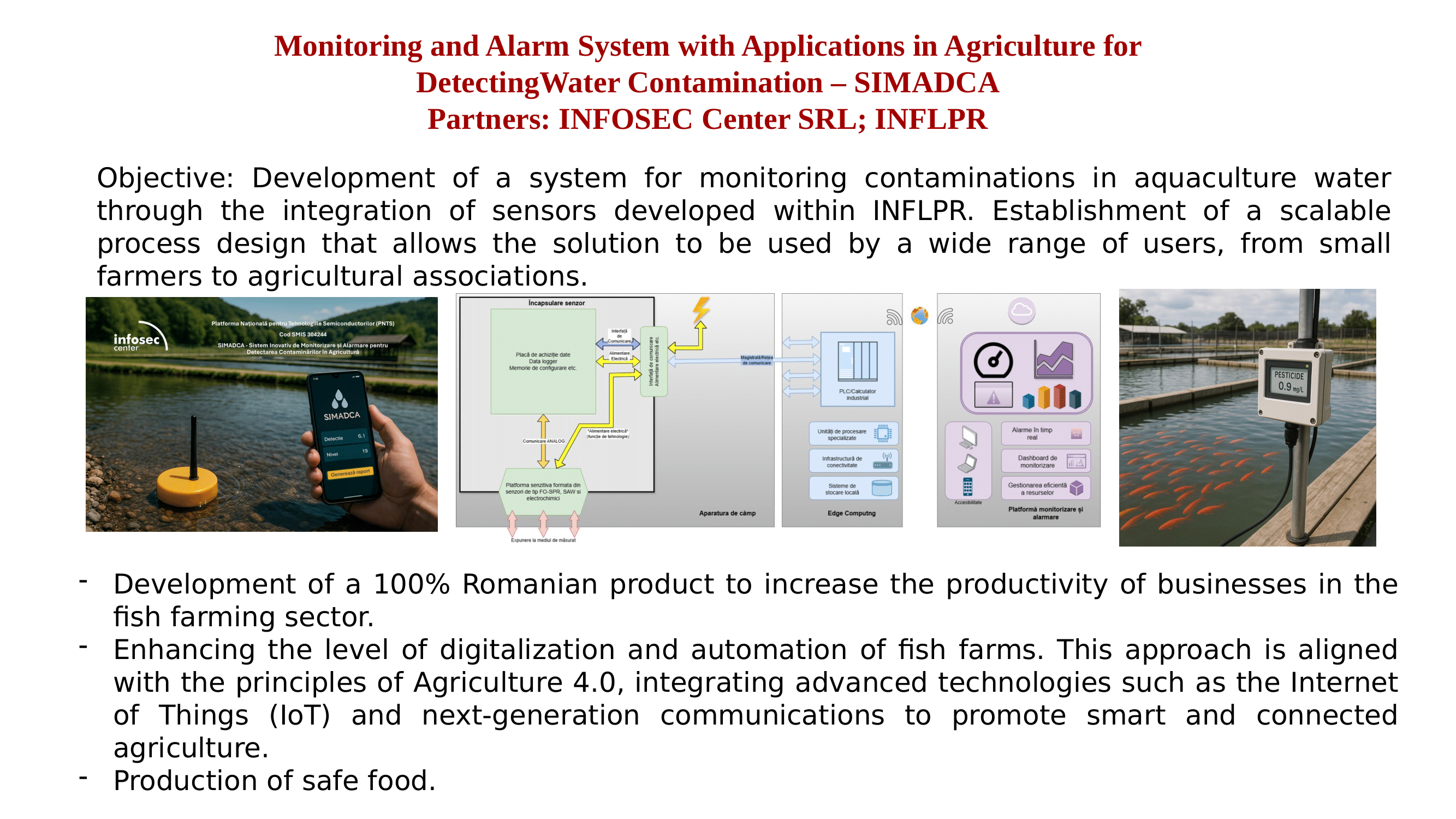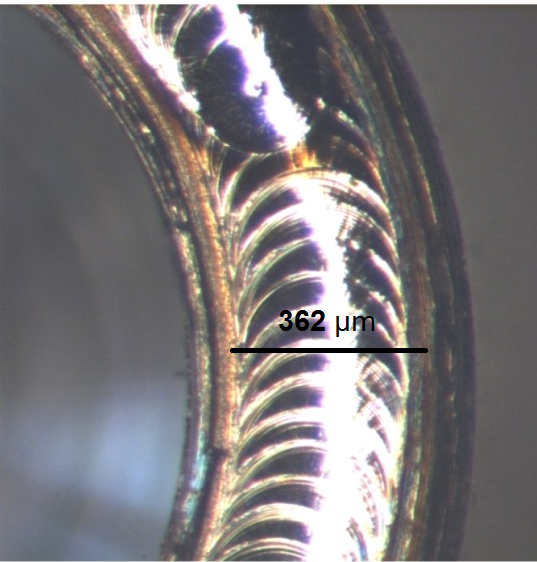 |
Research
 |
Major Research activities

|
Surface Acoustic Wave
 |
Development of Surface Acoustic Wave (SAW) gas sensors |
 |
SAW-type sensors for gas detection developed using laser technologies 
|
 |
Monitoring and Alarm System with Applications in Agriculture for DetectingWater Contamination – SIMADCA

|
 |
Development of Love Wave Surface Acoustic Wave (LW-SAW) biosensor |
 |
Nanowires for improving SAW sensor properties |
Micro and nanoprocessing
 |
Drilling, surface texturing, welding, cutting |
 |
 
Laser Texturing |
 |
Texturing of gear axes for improved tribological properties |
 |

Texturing of gear axes for improved tribological properties |
| |
 
Microwelding |
Dye sensitized solar cells and quantum dot solar cells
 |
Development of dye sensitized solar cells based on nanostructured thin films (TiO2 and ZnO) and quantum dot solar cells |
Laser deposition of various thin films
|
|  |
Transparent conducting oxides (ITO), polymers, semiconductors (TiO2, ZnO), dielectrics, ferro- and antiferromagnets (Co, Fe, Cr2O3), superconductors, ferroelectrics (SBT), etc. |
Nanopowders
 |
Synthesis of various nanometric powders: TiN, TiO2, AlN, Al2O3, SnO2, In2O3, NiO, ZnO, Fe3O4, C, SiO2, Si/SiO2, various metals ( Pt, Au, Pt, Pd, Ni), etc |
 |
Synthesis of core-shell nanoparticles with improved magnetic properties: Co-CoO, Ni-NiO, Fe-Fe3O4

|
 |
Synthesis of nanoparticles in size range 2 – 35 nm |
 |
Nanoparticle size selection leads to narrow size distribution |
Nanocomposites
 |
Nanocomposites with improved magnetic/ functional non-linear optical properties
|
 |

Co nanoparticles embedded in an Al2O3 matrix |
Quantum Dots
 |
Synthesis and characterization of quantum dots |
 |
Si/SiO2 QD: particle dimensions (2 – 10 nm) and photoluminescence (Vis - IR) |
 |
Polymer-grafted quantum dots for the formation of functionally active conjugates |
 |
QD applications in cellular biology and virusology |
 |
QD toxicology |
Some recent research results are:
- Production of nanostructures (SiO2/Si, TiO2, Al2O3, SnO2, In2O3, Fe3O4, ZnO, NiO, TiN, AlN, WO3, Pd, SnO2, Au) with dimensions below 35 nm, as well as nanowires (ZnO, MgO) and nanotubes. These nanostructures have applications in nanotechnologies and nanofluidics.
- Intelligent sensors for chemical warfare agents with applications in military detection techniques and security. For the first time in Romania, surface acoustic wave (SAW) sensors for the detection of chemical warfare agents were produced. The sensors have the following characteristics: detection limit 10 – 100 ppm, response time 10 – 50 s, repeatability +/- 10%. The detection limits obtained by our group are the same or better than the ones reported in scientific papers in the domain. The chemical warfare agents detected using our sensor were: chloropicrin, hydrogen cyanide, soman and lewisite. Nanocomposites (nanoparticles, nanotubes, fullerenes, nanowires) were developed for the improvement of SAW properties, as well as an improved technology for their deposition and techniques for testing for toxic and lethal gases. Sensors for the detection of hydrogen at room temperature were also developed (limit of detection 20 ppm).
- laser microtexturing configuration was designed and built, consisting in a mixed 4-axis translation-rotation-deflection system and a Lumera P50 laser system. Due to the large mass of the mechanical part which is processed, microtexturing occurs by deflecting the laser spot, while the part is only rotated about its axis. Deflection of the spot is done by using a galvanometer scanner. In order to increase the processed area, the scan head was mounted on a motorized translation stage.
The activities undertaken were directed towards partial texturing of a bolt chosen as the experimental model. This bolt is a component of a bearing in a CATERPILLAR 432 E buldoexcavator. Texturing was made using the laser micro-texturing set-up developed during the research activities in 2016. Part of the surface of the bolt was textured in accordance with the geometrical texturing configuration priorly determined to be the optimum one.
Validation of the partial texturing technology was made by evaluating the state of the textured vs. Non-textured areas of the same bolt, after hundreds of hours of operation of the buldoexcavator it was mounted on. Such partial texturing of the bolt allows us to conclusively compare the performance of the textured and non-textured areas, which undergo the same usage as the machines are operated. Analysis of the partially textured surfaces after such usage clearly shows differences between the laser-textured and non-textured areas. As seen in the figures, the untextured part has a large density of small defects on the surface, as well as extended parts where the material is burrowed, while the textured surface practically shows no signs of usage, looking identical to the way it was prior to being mounted on the machine.
- Nanotoxicology research on the effect of submicronic industrial powders on lung cells. Electrostatic precipitator systems were developed for the capture and analysis of powders containing particles of such dimensions, which are extremely hazardous for human health and very difficult to eliminate from industrial powders.
- Various types of dye-sensitized solar cells (DSSC) having applications in clean regenerable energy. The types developed were DSSC with TiO2 photoelectrode obtained directly by PLD (global efficiency 1.81%), and DSSC with TiO2 nanoparticles deposited by doctor blade method (global efficiency 9.6%)
- Study and development of biosensors based on Love Wave Surface Acoustic Waves for the detection of reaction antigen-antibody (for Aflatoxin B1; limit of detection 3 nM).
- The production and study of quantum dots (QD). The study of QDs using microscopy techniques, with laser excitation both in the continuous and fs regime was carried out. For the first time in Romania, the detection of antibodies specific to Actinobacillus pleuropneumoniae was achieved using a Western blot method based on QDs. The SiO2/Si QDs which were used for the detection of the antibodies have the advantage of presenting non degradation by exposure to UV radiation. In addition, the QD-based method used proved to be more sensitive than classical ones. Markers applicable in toxicology were also produced.
- The realization of nanocomposites with improved magnetic and nonlinear optical properties. The nanocomposites, obtained by sequential laser deposition, consist in nm-size metal nanoparticles of various shapes embedded in dielectric or antiferromagnetic matrixes. The magnetic nanocomposites have high blocking temperatures (150 K) and small dimensions (2 – 3 nm), with applicability in magnetic memories.
- Y-based High Temperature Superconducting (HTSC) thin films obtained by PLD having critical temperatures > 90K and transition widths < 0.5 K. HTSC thin films with critical currents increased by one order of magnitude were also obtained by incorporating nanostructures that produce vortex pinning. These superconducting materials have applicability in superconducting coatings for the transmission of energy with no loss.
- Laser welding of radioactive sources with cylindrical geometries using a YAG-Nd laser with a 50 mm focused beam. Welding process automation is obtained by syncronization of the laser system and the positioning system. The system was developed for cylindrical radioactive sources of various dimensions, but can be reconfigured for other geometries. The system has applications in the technology of nuclear materials, being a non-contact technique which ensures safety of the human operator.
- Systems for rapid micrometric texturing of plane and cylindrical surfaces, with applications in tribology, using a ps laser focused to 1 mm, with a positioning resolution of 500 nm.
Important Achievements:
- SAW for the detection of chemical warfare agents, H2S, H2, with limit of detection at room temperature of 5-100 ppm
- Love Wave biosensors (LW-SAW) have been developed to detect the antigen-antibody response (for Alpha-toxin B1) with a 3 nM detection limit and the ability to analyze the antigen-antibody response in real time
- In order to assess the effect of laser microtexturing on a bolt used in a CATERPILLAR 432 E buldoexcavator, the bolt was partially textured. After hundreds of hours of use in normal operating conditions, the differences between the textured and untextured parts of the bolt as are remarkable. The textured part of the bolt is practically unchanged through use, while the untextured part has a high density of point defects as well as entire areas with burrowing of the surface. These results prove the efficiency of the laser texturing method for parts operating in difficult industrial conditions.
- Detection of antibodies specific to Actinobacillus pleuropneumoniae using the Western blot method based on QDs achieved for the first time in Romania
- Dye sensitized solar cells with TiO2 photoelectrodes deposited by laser ablation for the first time
- Improved HTSC thin films with critical currents increased by one order of magnitude
- Development of a non-contact laser welding technique for cylindrical radioactive sources; the related patent was awarded the “Diploma of Excellence and the Silver Medal” at the International Exhibition of Inventions PRO INVENT, XII-a edition
|
Selected Research Projects

|
Ongoing projects:
Selected research projects:
-
-
-
-
-
-
Epitaxial YBCO films with strongly correlated pinning nanocenters for high temperature superconducting cables, 71-045/2008, (2008-2011)
-
-
Advanced technologies for reduction of the powders (including nanoparticles) in order to reduce the professional risks and improve health and safety at workplaces, 22-090/2008, (2008-2011)
-
Photovoltaic cells based on thin films obtained using alternative technologies for clean energy production, 22-132/2008, (2008 -2011)
-
-
Laser welding of capsule for radioactive sources, 71-132/2007, (2007-2010)
-
Application of surface texturing for reducing friction and wear in the case of sleeve bearings, 71-081/2007, (2007-2010)
-
Study of quantum dots by laser microscopy techniques, excited in continuum and femtosecond regime, 47GR/2007, (2007-2008)
-
The development of methods for capture and use of nanometric powders from industrial gas emissions, 54/2005, (2005 - 2008)
-
Development of new photovoltaic systems based on polymeric materials onto flexible substrates, 105/2005, (2005 -2008)
-
Development of mixed technologies for micro- and nanostructuring and integrated photonic systems with applications in communications, 16/2005, (2005 – 2008)
-
High critical temperature superconducting materials, 73/2005, (2005 – 2008)
-
Flux dynamics and structure in nanostructured and quasi-bidimensional superconductors, 21/2006, (2006 – 2008)
-
Quantum dots with applications in cellular biology and virusology, 4-61, (2004 – 2006)
-
High dielectric constant thin films obtained by laser ablation, C4-46, (2004-2006)
-
Eureka E!2841/Advanced pulsed laser deposition (PLD), a new technique for covering plane materials and 3-dimensional industrial components at low temperatures, (2003 – 2005)
|
|